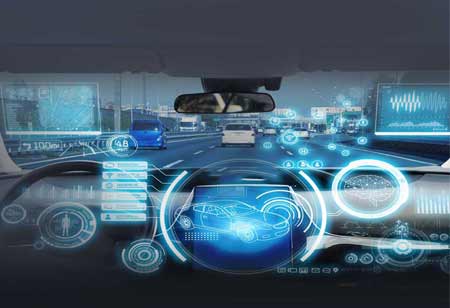THANK YOU FOR SUBSCRIBING
Be first to read the latest tech news, Industry Leader's Insights, and CIO interviews of medium and large enterprises exclusively from Food and Beverage Tech Review
Technological Advancements in the Food Business and Their Implications
Technological advances are reshaping the food industry, allowing companies to manage production, distribution, and consumption more efficiently.

By
Food and Beverages Tech Review | Thursday, March 30, 2023
Stay ahead of the industry with exclusive feature stories on the top companies, expert insights and the latest news delivered straight to your inbox. Subscribe today.
AI and automation can improve the way food is grown, produced, distributed, and supplied by using food tech.
Technological advances are reshaping the food industry, allowing companies to manage production, distribution, and consumption more efficiently.
The USDA estimates that the food industry contributes more than $1 trillion to U.S. gross domestic product. An industry this large has several challenges, including food sustainability. Technological advancements in the food industry are transforming the global food industry.
What is food tech?
Technological advancements in the food industry affect how people sell, produce, and distribute food and how food is produced.
It may sound new, but technology and food have been intertwined since the Industrial Revolution in the late 1700s and early 1800s. The industrialized agriculture of this period set the standard for farming and led to the emergence of industrial farming. Leaders in the industry and inventors collaborated during this time to increase food production and quality—many significant agricultural developments, including artificial fertilizers, pesticides, electric power, and steam-powered machines.
Food tech has become its sector with the rise of big data, artificial intelligence (AI), and the internet of things (IoT). IoT in all stages of the food supply chain can help the food industry become more sustainable.
Food sustainability challenges
According to Nature Food, the food system contributes nearly one-third of greenhouse gas emissions worldwide. Land-use changes, waste management, raising livestock, production, and packaging all contribute to these emissions.
According to a report by the FAO, about one-third of the world's food is wasted. Despite all this food waste, the World Health Organization estimates that nearly 828 million people do not have enough to eat.
With the energy consumed for food production and waste generated, agriculture, the food industry, and people's diets affect the environment. Agricultural practices affect the land and deplete it of nutrients. Agricultural land is declining along with water shortages.
The food tech industry is looking to address some of these issues. Startups are using the latest technology to create jobs, reduce hunger, and promote responsible consumption and production of food.
The impact of food tech
Emergen Research estimates that the global food tech market will grow to $342.52 billion by 2027 from $220.32 billion in 2019.
As technology advances, food production is increasing to reduce hunger and feed the world. With smart farming, agriculture is becoming more automated by using digital and advanced technology. Food production uses technology in the following ways:
Genetically modified organisms: GMOs are inserted into the genes of plants to help them grow in unfavorable environments. Large crops such as rice, wheat, and corn contain GMOs.
3D food printer: The use of food printers can create pizza, snacks, and candy at a higher rate. AI assists with the design of the layers and structure of the food by placing each ingredient one at a time. Reusing leftover ingredients could reduce waste.
Crop monitoring: AI can detect pests and diseases in crops with drones. Numerous digital apps, such as AgroPestAlert, Farm Scout Pro, and IPM Toolkit, can detect pest infestations and soil changes to prevent significant losses.
Meat industry technology: With AI, poultry producers can detect health issues with birds by listening to their sounds. AI robots can be used at poultry farms to collect eggs or assist with butchery.
Drones: Drones can provide satellite imagery to monitor crop growth and identify problem areas.
Various sectors in food tech
The food tech ecosystem includes lab-grown meat, vertical farms, and subcategories for each step of the food cycle.
Food science
Startups are exploring new ways to develop products that are both environmentally friendly and can address health concerns at the same time. Plant-based meat substitutes, including Beyond, are an example of a recent product in this category. The researchers use high-moisture extrusion and shear cell technology to create meal replacements for people with health issues and remove common allergies such as lactose intolerance.
Foodservice
Restaurants, cafeterias, hotels, and cafes are looking at automation to make their businesses more efficient. Restaurants of the Future will use robots to prepare and serve food.
Also, restaurants use IoT technology to manage supply orders and track ingredients. Restaurant owners can monitor storeroom shelves and delivery trucks' temperatures with sensors. All safety standards can be monitored throughout the journey.
Staff can maximize their time while they wait for items to cook by using smart appliances like meat temperature sensors and set-and-forget technology. Chefs can also manage time and orders using kitchen automation systems by tracking what needs to be cooked or how long something has been in a hot bin.
The delivery process
Transporting food is challenging due to supply chain disruptions. As direct delivery to consumers grows, including restaurant and grocery delivery and meal kits, technology is needed to track and ensure safe packaging and delivery.
Consumer services
Technology apps are helping consumers improve their diets, find restaurants, find recipes, and track allergies and specialized diets. For example, consumers can use apps to find allergen-free restaurants and follow their diets.
Additionally, startups are educating people on the benefits of proper nutrition in managing chronic health conditions and other fitness goals.
I agree We use cookies on this website to enhance your user experience. By clicking any link on this page you are giving your consent for us to set cookies. More info







